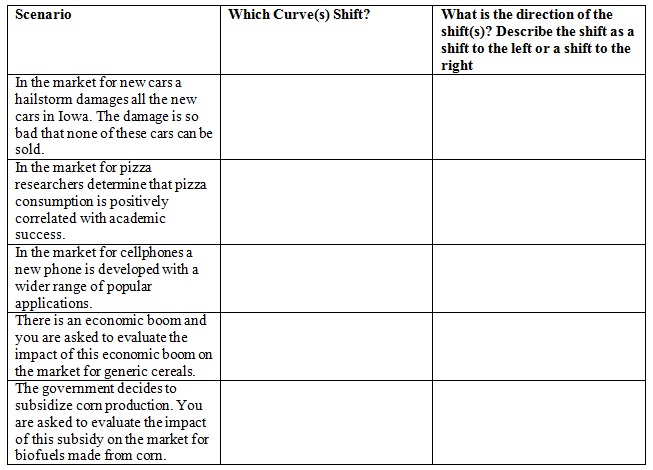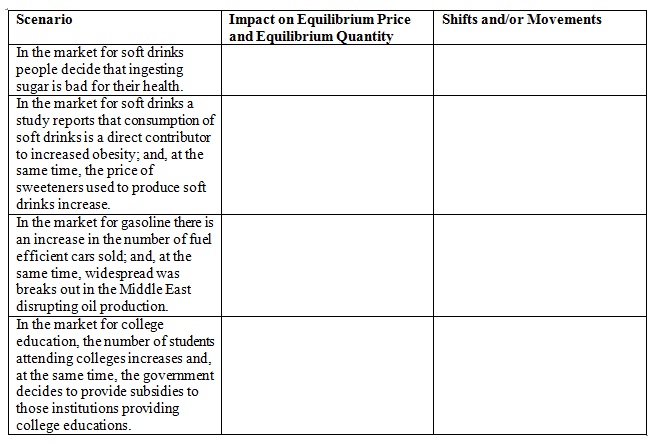Problem 1. For each of the following scenarios describe whether the demand curve and/or the supply curve shifts as well as the direction of the shift(s). Assume that each market is initially in equilibrium and that each market adjusts to the scenario to find its new equilibrium.

Problem 2. For each of the following scenarios describe the impact of the described change on the equilibrium price and equilibrium quantity in the chosen market. Describe any shift or movement that occurs as well. Assume that each market is initially in equilibrium.

Problem 3. Suppose that the price of bubble gum increases. This results in Suzy buying more candy bars and fewer sweet tarts. From this information and holding everything else constant, what do you know about Suzy’s view of candy bars and sweet tarts relative to bubble gum? Explain your answer fully using complete sentences. Strive for conciseness and clarity!
Problem 4. Consider the market for soybeans. The market demand and supply curves are as follows where P is price per bushel of soybeans and Q is the quantity of soybeans measured in bushels:
Market Demand: Q = 10,000 – 1000P
Market Supply: Q = 250P
a. Given the above information, what is the equilibrium price and quantity of soybeans? Show your work.
b. Given the above information, what is the value of consumer surplus (CS), producer surplus (PS), and total surplus (TS)? Show your work for each of these calculations.
c. Suppose soybean farmers successfully lobby the government to institute a price floor in this market. To be effective, what must be true about this price floor? Use complete sentences to answer this question and provide specific numeric guidance with regard to this effective price floor.
d. Suppose the price floor is implemented and it results in the government cost (excluding any storage costs) of $11,250. Given this information, calculate the price the government set as the price floor. Show your work and your reasoning in a neat, easy to follow answer!
e. Given the price floor described in (c) and calculated in (d), what is the value of consumer surplus with the price floor (CS’) and the value of producer surplus with this price floor (PS’)? Show your work and your reasoning.
Problem 5. Consider the market for luxury sport utility vehicles. Suppose that the demand and supply curves for these vehicles is given by the following two equations where P is the price per vehicle measured in thousands of dollars and Q is the quantity of vehicles measured in millions of vehicles:
Market Demand: P = 80 – 2Q
Market Supply: P = 20 + Q
a. Given this information, what is the equilibrium price and the equilibrium quantity in the market for luxury sport utility vehicles? Show how you found your answer and make sure you include the correct scale for both measures (thousands of dollars and millions of vehicles).
b. Given this information, what is the value of consumer surplus (CS) in this market? What is the value of producer surplus (PS) in this market? Show how you found your answer and make sure you include the correct scale for both measures.
c. Suppose that the government decides that the current price of luxury sport utility vehicles is too high. The government passes a price ceiling for this market where the price of a luxury sport utility vehicle is set at $30,000 per vehicle.
i. Given this price ceiling, how many luxury sport utility vehicles will be demanded?
ii. Given this price ceiling, how many luxury sport utility vehicles will be supplied?
iii. Given this price ceiling, which side of the market is the “short side”?
iv. What is the value of consumer surplus with this price ceiling (CS’)?
v. What is the value of producer surplus with this price ceiling (PS’)?
vi. Who do you think lobbied the government for the imposition of this price ceiling? Explain the reasoning behind your answer.
vii. Is there a deadweight loss with this price ceiling (DWL)? If there is a DWL, calculate its value.
Problem 6. Let’s return to the set-up you were given for problem 5. But, instead of a price ceiling let’s analyze the impact of a quantity control on the market for luxury sport utility vehicles. Suppose that the government decides that driving these cars represents a huge negative externality to the residents of this country and that the government should actively intervene to limit the number of luxury sport utility vehicles that are sold. The negative externality is an idea we will study later in the semester, but basically in this example this negative externality refers to the costs society incurs when people drive gas guzzling cars: pollution costs, environmental damage, contribution to climate change, etc. Suppose that the market demand and supply curves you were given in problem 5 still describe this market, but now the government has imposed a quantity control or quota of 10,000,000 vehicles in this market. That is, the government has decreed that only 10,000,000 luxury sport utility vehicles can be sold during the current time period.
a. How does the quantity control affect the price that producers of these vehicles will charge demanders of these vehicles?
b. How does the quantity control affect the value of consumer surplus (CS”) in this market?
c. How does the quantity control affect the value of producer surplus (PS”) in this market?
d. Is there a DWL from the imposition of this quantity control? If so, provide a numeric measure of the DWL.
e. If the government sells licenses to car producers for the right to provide these vehicles, what is the maximum per luxury sport utility vehicle a supplier will pay for this right?
f. Draw a diagram that illustrates the effect of this quantity control on this market. In your diagram label CS”, PS”, the area that represents the total amount car producers would be willing to pay for the right to provide these vehicles, and any area of DWL.